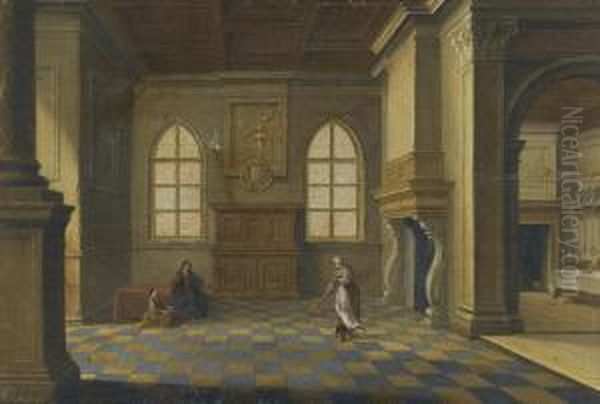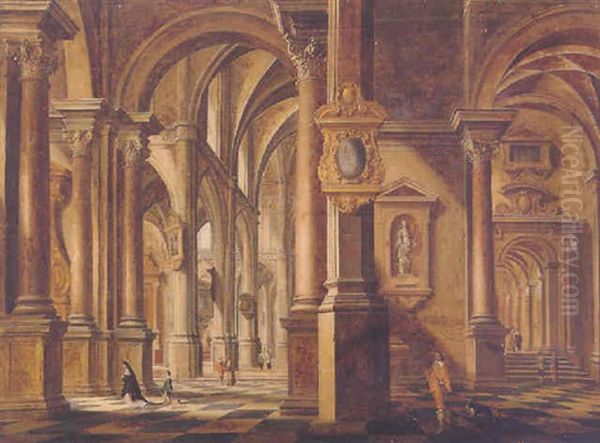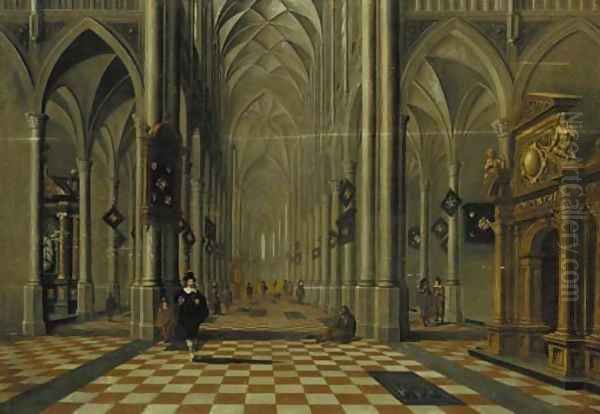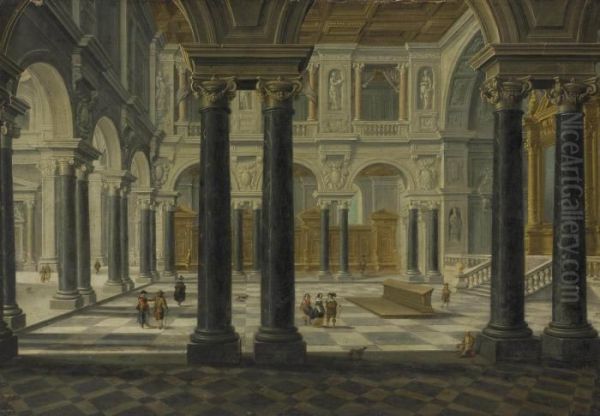Bartholomeus van Bassen stands as a significant, albeit sometimes overlooked, figure in the rich tapestry of the Dutch Golden Age. Active during a period of immense artistic innovation and output, Van Bassen distinguished himself not only as a skilled painter but also as a practicing architect. His primary contribution to art history lies in his specialization in architectural interiors, a genre he helped pioneer and popularize in the Netherlands during the first half of the seventeenth century. His works offer fascinating glimpses into both real and imagined spaces, rendered with meticulous attention to perspective and detail.
Early Life and Uncertain Beginnings
The precise origins of Bartholomeus van Bassen remain shrouded in some mystery, a common occurrence for artists of this period. While traditionally thought to have been born in Antwerp around 1590, definitive documentation is lacking. Some scholars suggest alternative possibilities, including a potential connection to a family from Arnhem. What is known is that he was the illegitimate son of Cornelis van Bassen. His grandfather, also named Cornelis van Bassen, was recorded as having died in The Hague, suggesting a family presence in the Dutch Republic prior to Bartholomeus's own established career there.
Details regarding his artistic training are equally scarce. It is unclear under whom he formally studied, leaving his early development and influences open to speculation. However, his later mastery of complex perspective and architectural rendering suggests a rigorous, though unrecorded, education in these principles, possibly influenced by Flemish traditions prevalent in Antwerp or early Dutch practitioners. His official entry into the art world is marked by his registration as a member of the Guild of Saint Luke in Delft in 1613, indicating he had achieved a recognized level of professional competence by his early twenties.
Establishment in The Hague and Guild Activities
After nearly a decade associated with the Delft Guild, Van Bassen made a significant career move in 1622, relocating to The Hague. This city, as the administrative center of the Dutch Republic and the seat of the House of Orange, offered considerable opportunities for patronage and prestigious commissions. Upon arrival, he promptly joined the local Guild of Saint Luke, integrating himself into the city's artistic community.

His standing within the Hague Guild grew steadily over the years, reflecting his professional success and respect among his peers. Records show he held several important positions within the organization. In 1627, he served as Dean (Deken), a leadership role responsible for overseeing guild affairs. Later, he held the position of Headman (Hoofdman) for an extended period, from 1636 to 1640. Furthermore, his expertise in building was officially recognized when he was appointed to the guild's building committee in 1639. These roles underscore his dual identity as both a respected painter and a knowledgeable figure in architectural matters.
The Architectural Painter: A New Specialization
Bartholomeus van Bassen is widely regarded as one of the first Dutch artists to specialize primarily in architectural painting. While earlier artists, particularly in Flanders like Hendrick van Steenwijck the Elder and his son Hendrick van Steenwijck the Younger, had depicted church interiors, Van Bassen focused intensely on this genre within the context of the Dutch Golden Age, developing a distinct approach. His oeuvre consists largely of interior views, encompassing both grand church spaces and opulent palace settings.
A significant portion of his work features imaginary or composite architectural scenes. These paintings are not necessarily accurate depictions of specific existing buildings but rather idealized constructions showcasing his skill in perspective, his understanding of architectural styles (often blending Renaissance and Baroque elements), and his delight in depicting luxurious materials and intricate ornamentation. Tiled floors recede convincingly into space, arches soar, and light often streams through tall windows, illuminating the carefully constructed interiors. This focus on architectural accuracy and spatial illusion was a hallmark of the genre.
Artistic Style and Thematic Content
Van Bassen's style is characterized by clarity, precision, and a strong sense of order. His mastery of linear perspective allowed him to create convincing illusions of deep space within his canvases. His architectural elements are rendered with fine detail, paying close attention to columns, capitals, vaulting, and decorative features like statues or reliefs. While some early works lean towards more fantastical or Mannerist-influenced architectural inventions, potentially showing the influence of designers like Hans Vredeman de Vries whose perspective treatises were widely circulated, his later works sometimes exhibit a greater degree of naturalism.
His architectural settings often serve as stages for small figures, known as staffage. These figures, sometimes painted by Van Bassen himself and sometimes added by collaborators, animate the spaces and provide narrative context or genre elements. Frequently, these figures form 'merry companies' – groups of elegantly dressed men and women engaged in social activities like dining, drinking, conversation, or playing music. This inclusion adds a layer of contemporary life and luxury to the imposing architectural backdrops.

Beyond genre scenes, Van Bassen also incorporated biblical and historical themes into his architectural interiors. Works like The Return of the Prodigal Son or Christ in the House of Mary and Martha use the grand architectural setting to frame the religious narrative, lending it a sense of drama and importance. The contrast between the intimate human story and the vast, enduring structure is often a key element of these compositions. His palette is generally clear and bright, contributing to the overall sense of elegance and order.
Collaboration with Contemporary Artists
Collaboration was a common practice in the Dutch Golden Age, allowing artists to leverage specialized skills. Van Bassen frequently worked with other painters who would add the staffage (figures) to his meticulously rendered architectural scenes. This practice allowed him to focus on his area of expertise – the architecture itself – while ensuring the figures were painted by specialists in that domain.
Among his known collaborators were prominent artists of the time. Anthonie Palamedesz., known for his guardroom scenes and merry companies, likely contributed figures that enhanced the genre aspect of Van Bassen's interiors. Esaias van de Velde, a versatile artist skilled in landscape and genre painting, also collaborated with Van Bassen, bringing his lively figure style to the architectural settings. Another collaborator mentioned is Jan Martszen de Jonge, a painter known for his battle scenes and cavalry skirmishes, suggesting he might have added specific types of figures or narrative elements. These collaborations enriched Van Bassen's work and situated him within a network of active Hague painters.
The artistic environment of the Dutch Golden Age was vibrant and competitive. While Van Bassen specialized, he worked alongside artists excelling in other genres, such as the great portraitists Frans Hals and Rembrandt van Rijn, the subtle interior painter Johannes Vermeer, and fellow architectural specialists like Pieter Saenredam, known for his precise and luminous depictions of real Dutch churches, and Emanuel de Witte, famed for his atmospheric church interiors often filled with worshippers. Van Bassen carved his niche within this bustling scene.
Architectural Endeavors: Bridging Painting and Practice
Van Bassen's engagement with architecture extended beyond depicting it on canvas; he was also a practicing architect. This dual expertise is relatively unique and informs his painted work, lending it an air of structural plausibility even in his imaginary compositions. His practical knowledge of building likely enhanced his ability to render complex structures accurately.

One of his significant architectural projects involved work for Frederick V, the Elector Palatine, who briefly reigned as King of Bohemia and was subsequently known as the "Winter King." After Frederick went into exile in The Hague, Van Bassen was involved in the design and construction of his residence, sometimes referred to as the "Huis van de Koning van Bohemen" (House of the King of Bohemia), likely located in Rhenen near Utrecht, though sources sometimes mention Utrecht itself. This connection to courtly circles highlights his professional standing.
Furthermore, Van Bassen undertook civic projects. He is credited with designing the facade for the Town Hall (Stadhuis) of The Hague, a prominent commission that would have significantly impacted the city's appearance. His involvement in the Guild of St. Luke's building committee also points to his recognized architectural skills. This practical experience undoubtedly fed back into his paintings, giving his depictions of palaces and civic buildings a particular authority.
Notable Works: Visions of Space and Splendor
Several key works exemplify Bartholomeus van Bassen's artistic output and style. His painting The Great Hall of the Binnenhof, The Hague provides a valuable depiction of the interior of this historically significant complex, which housed the governmental functions of the Dutch Republic. It showcases his ability to handle large, complex interior spaces and populate them with figures suggesting political or social gatherings.
Another important work, The Great Assembly of 1651, also likely set within the Binnenhof complex, captures a specific historical moment: a major meeting of representatives from the seven provinces of the Dutch Republic. The painting serves as both an architectural study and a historical document, depicting the setting where crucial political discussions took place, complete with details like flags representing different regions.
His church interiors, such as Interior of a Catholic Church (Mauritshuis) or Interior of an Imaginary Church with the Tomb of William the Silent (Budapest), demonstrate his skill in rendering ecclesiastical architecture, often blending Gothic and Renaissance elements. The latter work is particularly interesting for its inclusion of the famous tomb monument located in the Nieuwe Kerk in Delft, placed within a fantastical architectural setting, bridging reality and imagination. Works like Interior of Antwerp Cathedral (if correctly attributed and representing an early work) and Interior of a Church with a Procession further illustrate his focus on sacred spaces.

His narrative works set within architectural contexts, like Return of the Prodigal Son (Detroit Institute of Arts), showcase his ability to integrate storytelling with his primary focus on architecture, using the setting to amplify the scene's emotional or moral weight. These representative works collectively highlight his mastery of perspective, his interest in both real and imagined structures, and his contribution to the genre of architectural painting.
Teaching and Influence on Later Painters
As an established master in The Hague, Van Bassen also took on pupils, passing on his specialized knowledge. His most notable student was Gerard Houckgeest. Houckgeest initially worked in a style similar to Van Bassen's, depicting somewhat imaginary architectural spaces. However, Houckgeest later became a leading figure in the Delft school of architectural painting, alongside Emanuel de Witte and Hendrick Cornelisz. van Vliet, developing a new approach characterized by more naturalistic depictions of existing church interiors, often using innovative oblique perspectives rather than the strict central perspective favored by earlier artists.
Van Bassen's influence, therefore, extended through his teaching to the next generation of architectural painters. While artists like Houckgeest ultimately moved in different stylistic directions, Van Bassen's pioneering work in establishing architectural interiors as a viable and respected genre provided a foundation upon which they could build. His emphasis on perspective and detailed rendering remained influential. His success helped pave the way for the flourishing of architectural painting in Delft and beyond during the mid-seventeenth century.
Legacy and Rediscovery
Despite his skill and his pioneering role in architectural painting, Bartholomeus van Bassen's name was not always prominent in historical accounts of Dutch art. Contemporary mentions are relatively scarce compared to some of his more famous contemporaries. Like many artists from the period, his reputation experienced periods of obscurity. It was largely through the efforts of art historians in the 19th and 20th centuries that his contributions were re-evaluated and his significance fully recognized.
Today, he is acknowledged as a key figure in the development of Dutch architectural painting. His works are valued for their technical skill, their elegant compositions, and the insights they offer into the aesthetics and architectural interests of the Dutch Golden Age. His dual career as both painter and architect provides a fascinating case study of the intersection of these disciplines during the period. His paintings are held in major museum collections across the world, ensuring his legacy endures.
Later Life and Death
Bartholomeus van Bassen remained active in The Hague throughout his career. His last known dated works place him active into the early 1650s. He died in The Hague in 1652, likely aged around 62. He left behind a significant body of work that continues to attract scholarly attention and admiration from museum visitors.
Conclusion: Architect of Painted Worlds
Bartholomeus van Bassen occupies a unique and important place in Dutch Golden Age art. As both a practicing architect and a specialized painter of architectural interiors, he brought a distinct perspective to his canvases. He was instrumental in establishing architectural painting as a significant genre in the Netherlands, creating works celebrated for their perspectival accuracy, detailed rendering, and often luxurious atmosphere. Through his paintings of real and imagined churches and palaces, his collaborations with figure specialists, his own architectural projects, and his influence on pupils like Gerard Houckgeest, Van Bassen left an indelible mark on the art of his time. His rediscovery has rightfully restored him to a position of significance among the masters of the Dutch Golden Age.